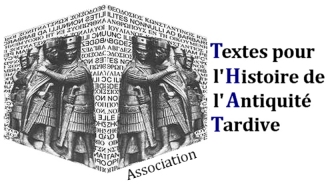NB : Pour lire l’intégralité des articles, voir ci-contre la rubrique Téléchargements.
Les dossiers de la Correspondance d’Ambroise. Bilan et perspectives. Actes de la journée d’études (28 novembre 2013, Palais Universitaire, Strasbourg), édités par MICHELE CUTINO et FRANÇOISE VINEL, décembre 2014 (XXII + 211 p.).
[publication en ligne : 31/12/2014]
—Avant-propos, par MICHELE CUTINO et FRANÇOISE VINEL – p. III-VI.
∴∴∴
Conférence inaugurale
1. HERVÉ SAVON
L’Église dans l’histoire et dans l’État : Ambroise de Milan – p. VII-XXI.
Abstract: Ambrosius had a major role in the definition of ecclesiastic and civil domains : it is known that the separation between sacerdotium and imperium (usually unified in pagan system) started during the fourth century AD. The author of this article offers an analyse of Ambrosius’ interventions in both spheres, the religious and the secular one.
Les dossiers
2. HERVÉ SAVON
La structure et la formation du « livre IX » de l’édition Faller–Zelzer des lettres d’Ambroise – p. 3-13.
Abstract: This article offers a report of Ambr., epist. IX 62-69, which is a description of how Moses’ law ceased to be applied. The relationship between the bishop and his model Origen is inquired too.
3. GÉRARD NAUROY
Qui a organisé le Livre X de la Correspondance d’Ambroise de Milan ? – p. 15-30.
Abstract: The aim of this work is to investigate how the last book of Ambrosius’ letters has been prepared : as a matter of fact, these letters seem to have been choosen and regrouped to form a very homogeneous dossier, in the purpose of proving bishop’s attachment to the city and describing his relationship with the imperial power.
4. FRÉDÉRIC CHAPOT
La correspondance d’Ambroise de Milan : analyse du dossier C, Lettres 11 (M 29) à 16 (M 76) à Irénée – p. 31-46.
Abstract: The six letters numbered from 11 to 16 in the edition of O. Faller and M. Zelzer, all sent to Irenaeus, probably a cleric of the Church of Milan, make up a sequence in the collection. The study of these letters attempts to highlight the thematic and exegetical links between them and, if we consider this whole as a file, the progression from the 1st letter (the exhortation to attain the sovereign good) to the 6th letter (the perfect man), and the coherence of the intermediate letters, founded on the scriptural corpus particularly.
5. ALINE CANELLIS
Les Epistulae 18 (M 70), 19 (M 71), 20 (M 77), 21 (M 34), 22 (M 35), 23 (M 36) d’Ambroise de Milan à Orontianus – Étude du Dossier D – p. 47-59.
Abstract: The Epistulae 18-23, sent by Ambrose to the priest Orontianus, are difficult, even impossible to date ; they form a series, as already give evidence of it the old manuscripts. Besides, the choice of the handled themes, the desire to explain the difficult passages of the Holy Scriptures, the effort of answering Orontianus’ questions make of these six letters a « dossier exégétique », informed by philosophy and theology.
6. CAMILLE GERZAGUET – PAUL MATTEI
Les lettres d’Ambroise extra collectionem. Présentation philologique du dossier. Approche historique et doctrinale – p. 61-85.
Abstract: The group of letters extra collectionem of Ambrose gives rise to two crucial points. The first one deals with the unity of these letters which are divided into two subsets. The publication of the first subset is generally ascribed to Paulinus of Milan. Only this one has a consistency based on the textual tradition. The second question is related to the existence of thematic subsets which are easy to be made out. Two are commented : the correspondance about the Council of Aquileia and the one about the usurpation of Eugenius. Some additionnal documents complete the paper, among them three previously unpublished translations.
7. MICHELE CUTINO
Les finalités et l’organisation de la correspondance d’Ambroise : un projet inachevé – p. 87-144.
Abstract: In this paper we examine in depth the programmatic reflections on the correspondence of Ambrose, in order to compare with the collection of letters that the manuscript tradition has transmitted to us. A comprehensive examination of the data suggests that Ambrose has designed the project to publish his letters, but he has not completed this.
Aspects formels et exégétiques des épîtres
8. FRANÇOISE VINEL
L’épître 2 et la méthode exégétique d’Ambroise – p. 147-159.
Abstract: Letter 2 Ambrosius sent to Simplicianus gives important informations about Ambrose’s biblical exegesis. About some verses of Old Testament (Exodus 24, 5-6), Ambrose develops a christological reading, and defines the different interpretative levels, especially moralis and mystica lectio.
9. LAURENCE GOSSEREZ
Le reflet de l’Exameron dans les lettres d’Ambroise de Milan (6, 29 ; 6, 31 ; 6, 34) – p. 161-190.
Abstract: This article demonstrates that four letters of Ambrose (6, 29 ; 6, 31 ; 6, 34 ; epist. 14 extra collectionem) form a thematic coherent group unified by the intertextuality. In these letters Ambrose alludes to Philo, Origen and especially to Georgics of Virgil. He explains the numerical symbols and the allegorical garden. Referring implicitly to Qo 7, 25, he defines the hybrid genre of exegetic commentary related to the didactic and philosophical epic tradition. Thereby he gives the poetic, mystic and musical key of Exameron.
10. SMARANDA BADILITA
Les références à Gn 9, 20-21 dans la correspondance d’Ambroise – p. 191-198.
Abstract: This paper studies the references to Gn 9, 20-21 in three of the letters of Ambrose : 27 (M. 58), 29 (M 43) and 38 (M 43).The analysis of these texts highlights the exegetical link between the correspondence of Ambrose and the rest of his work, while revealing at times Philo’s influence.

